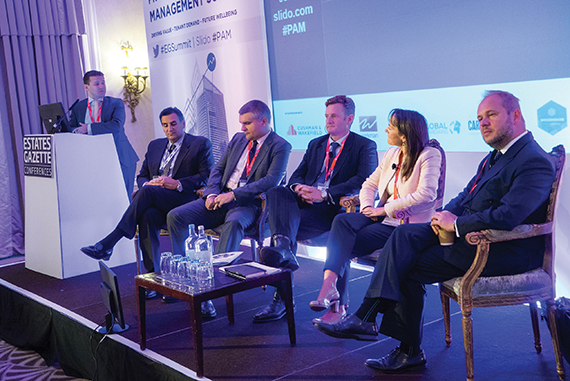 To be a successful asset manager in 2017, align your interests with those of your investors. To succeed in the years beyond that, embrace technology – including working with robots. Those were two of the headline messages to emerge from this autumn’s EG property asset management conference.
To be a successful asset manager in 2017, align your interests with those of your investors. To succeed in the years beyond that, embrace technology – including working with robots. Those were two of the headline messages to emerge from this autumn’s EG property asset management conference.
For Richard Croft, chief executive of M7 Real Estate, alignment is the key to success. “The way that we manage capital is to make sure that our alignment of interest is in the interest of our partners,” he told delegates.
“The key thing is to convince people that you are aligned with them and the mistake is to take assets under management without doing this.”
Equally, it is important to focus your attention and skill set to a particular asset class in order to have a clear strategy for your assets and investors.
Croft added: “It is important that you do what you do because you are good at it and you don’t stretch too far out. If you stretch, you become all things to men and you don’t do anything that well.”
John Maddison, partner at Quadrant Estates, said: “You have to differentiate yourself from the world of investment agency, and if you have a partner, you need to be clear that your plans match theirs.”
Extending understanding of assets to the tenants of the buildings is also at the heart of successful asset management. This enables asset managers to adapt to their occupiers’ needs and achieve rental growth, and is particularly important for the office sector.
Susana Clarke, head of asset services, Spain, at Cushman & Wakefield, said: “We have to really understand the occupiers of the buildings and their changing requirements. They are not paying for the sake of it – it is all about who lives and works in the buildings.”
Beyond understanding and alignment of interest, it is also vital to remember that property asset management is also built on relationships and trust.
Maddison said: “Property is a people business and you must never forget that the way to get an investor over the line is based on trust and a good relationship.”
Matt Kelly, investment director at Anglezarke, said: “When you meet people, you have to totally understand what their objectives are and how you are going to invest their money.”
But other speakers at the event were focused on what comes next.
According to Nikhil Vadgama, founder of data and artificial intelligence-led platform Placemake.io, robots are a big part of the property industry’s future, whether or not they replace people.
 Vadgama spoke about a hotel in Japan where many jobs, such as reception, security and cleaning, were filled by robots.
Vadgama spoke about a hotel in Japan where many jobs, such as reception, security and cleaning, were filled by robots.
“How quickly can artificial intelligence learn from the data that is presented to it and train itself to mimic a higher functionality?” he asked.
“Do you still need someone who has to deal with a higher level of functionality, or how long before a robot can do all that stuff?”
Juliette Morgan, head of the futures group at Cushman & Wakefield, added: “What we will end up with is collaboration. We will use tech to make work more efficient and spend much of our time on complex transactions that need the skill and insight of a person.
“A computer can tell you yes or no, but it can’t read the market and tell you over the last four cycles what it is doing. I know you can get code to write beautiful music, but I don’t see that shift in our industry – the complexity of our transactions isn’t something that can be automated.”
Vadgama disagreed. “Machines could tell the industry what the opportunities should be. That is what we are trying to do and we can already do a little bit of that stuff. The big data is enabling you to look at trend correlations in real time,” he said.
But the panel agreed on the importance of big data.
Vadgama said proptech companies were still unclear how to use it, and that unlocking value from data was still a “huge issue”.
Morgan added: “Chief executives across the world are accessing and harnessing data, but cleaning that data and making sure it is useful is important.”
But Jakub Wojciechowski, chief executive at Silvertown, which uses data to help with asset management, cautioned on the need for privacy.
He said: “For me, the more data, the better. The more I have, the better insight I have, but some are scared of collecting data and the risks with storing it and compliance with ICO regulations.
“So before we move to the level of using big data, we need to address questions of security and find a good platform of data sharing.
“We need to take privacy into account.”
Listen to podcasts from the summit and an interview with Richard Croft here.
Rates ruckus rumbles on
The Autumn Statement did nothing to tackle the business rates appeal regime. And it was a panel at EG’s autumn property asset management conference that best highlighted many of the problems with the current system.
Delegates heard about the depth of opposition to changes to appeals, which mean a revaluation can only be ordered if the valuation is so wrong as to be “outside the bounds of reasonable professional judgment”.
Business rates consultant Blake Penfold, a former member of the RICS Valuation Standards Board, said: “I can’t think of any other area of tax where an independent tribunal could determine a tax liability was too high but not be able to adjust it to the correct judgment because it falls in the bounds of professional judgment.”
Jonathan Cole, acquisitions manager at Ellandi, said any appeal could still take up to 36 months to resolve. He said he believed the purpose of the changes to appeals was to make it much more difficult to win a revaluation and “to stop appeals being made in the first place – it is more difficult to get to the final stage”.
The summit also heard about the cost of appealing against incorrect rate revaluations. Penfold said that for the first time, an appeal fee – £300 – had been brought in, although non-businesses and small businesses, a category that included the Treasury, would pay a smaller fee of £150.
Penfold also warned against mitigation tactics. Some charities had been set up for the express purpose of helping businesses mitigate rates because charities enjoy 80% of rate relief. But he said some had been challenged and investigated by the Charity Commission over whether the purpose of the charity was truly connected to the use of the building.
However, Penfold said there were legal schemes involving charities which could be used, and also advised making use of occupancy, for example, occupying a building for six weeks to claim three months.
Twitter wall
If I take anything away from today it is the astonishing fact that in 2017, 40% of commercial leases are coming up for expiry #EGSummit
— Chris Yannaghas (@cyannaghas) October 11, 2016
@Woodhouse_wksp Technologies to look out for…@Pavegen and li-fi. #smarterworkspaces
@cyannaghas The next big thing; LiFi taking over from wifi; future technology potential is astounding
@timothy_burgess @Juliettemorgan “Buildings produce 80% of emissions in cities; they need to become more self-aware”. Excellent role model
@dkatsikakis Big data like teenage sex? Better to layer small data #PlaceMake #EGSummit
https://twitter.com/remitsteph/status/785812996417265664
@remitsteph 75% of industry thinks it’s behind tech curve & 89% believe tech can improve service. So why not invest?
@QubeGlobal @EGi_Research #EGSummit
@JD_WigleyGroup The asset manager with the most added value is the one with the least emails & the most mileage – Simon Cooke from APAM Ltd
@JD_WigleyGroup To maximise the value of your asset you need to understand your asset. Get on site, meet the tenants, & appreciate its constraints
@JD_WigleyGroup Biggest key challenge in next few years for asset managers is achieving rental growth & working with tenants
@EstatesGazette
@Woodhouse_wksp #EGSummit – don’t try and be all things to all men, be a specialist! #smarterworkspaces











